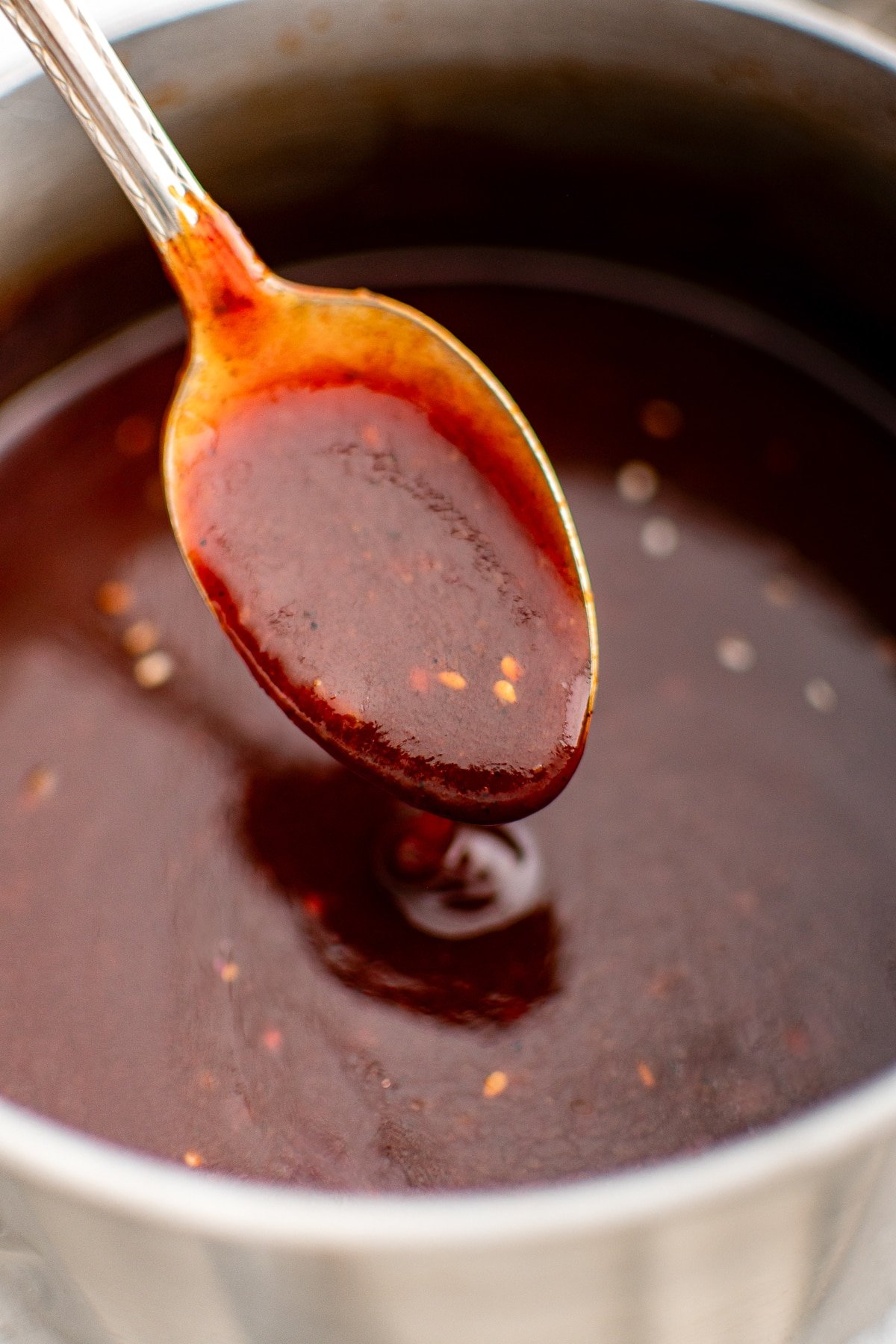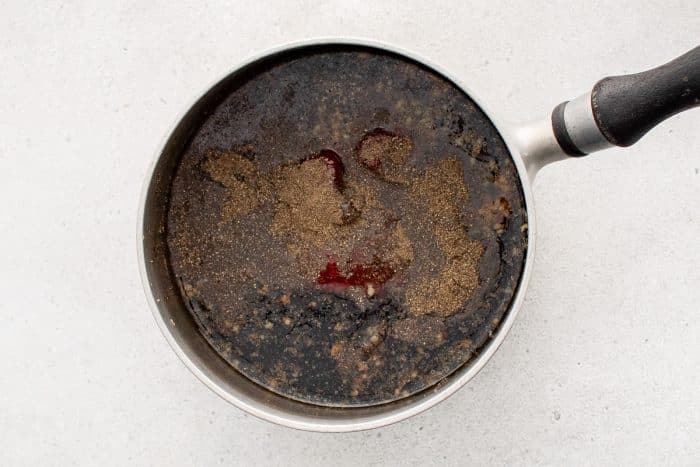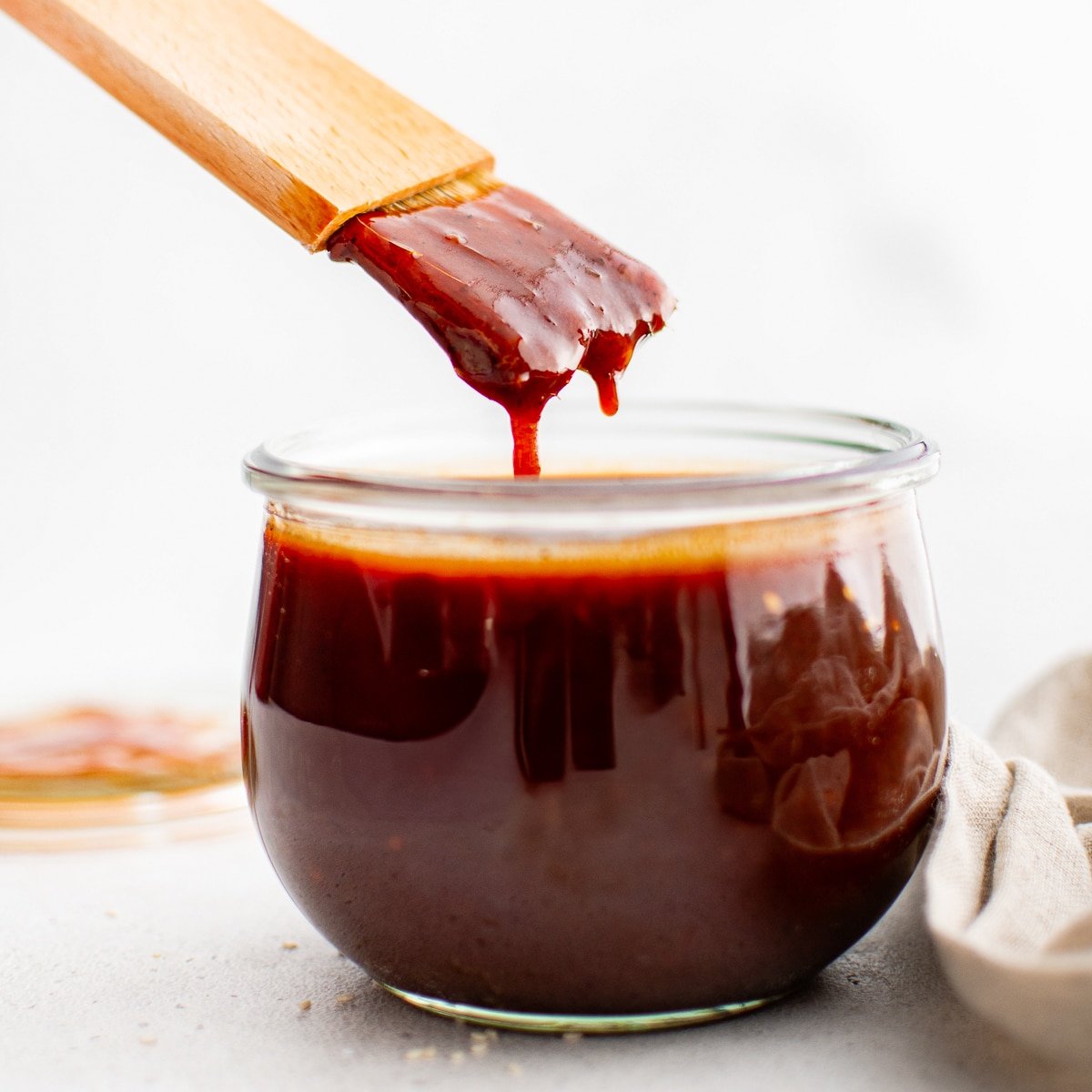This post may contain affiliate links. Please read our disclosure policy.
This Korean BBQ Sauce blends gochujang, soy sauce, garlic, and brown sugar for the perfect balance of sweet, savory, and spicy flavor. It’s super easy to make! Keep a jar the fridge to use as a glaze, dipping sauce, or marinade for everything from grilled meats to crispy chicken wings!

About This Recipe
If you’re looking for the perfect sauce to level up your next barbecue night, this homemade Korean BBQ sauce is one of my all-time favorites. It’s thick, slightly sticky, and packed with the perfect balance of sweet, savory, spicy, and (just a little) tangy flavors.
I love slathering it onto grilled meats from simple BBQ chicken to Korean BBQ beef short ribs (kalbi) or stirring some into noodle dishes like spicy ramen noodles, stir fried udon (yaki udon), and pork filled dan dan noodles. It’s even amazing as a dip for crispy fried chicken. However you use it, this versatile sauce delivers big flavor with minimal effort. Plus, it’s easy to make in just minutes and stores beautifully in the fridge for weeks.
Table of contents
What is Korean BBQ Sauce
Korean BBQ sauce, or bulgogi sauce in some variations, is a flavorful condiment commonly used in Korean cuisine to marinate and glaze grilled meats like beef, pork, or chicken. It’s typically made with a combination of soy sauce, sugar, garlic, sesame oil, and gochujang—a fermented Korean chili paste that adds depth and gentle heat. The result is a rich, umami-packed sauce that caramelizes beautifully on the grill and pairs just as well with stir-fries, rice bowls (like Korean Bibimbap), and even roasted vegetables. Unlike American-style BBQ sauce, which leans heavily on smokiness and tomato, Korean BBQ sauce focuses more on balance and bold umami flavor.

Ingredient Spotlight: Gochujang Paste
Gochujang is a thick, fermented Korean chili paste made from red chili pepper flakes (gochugaru), glutinous rice, fermented soybeans, and salt. It is spicy, savory, slightly sweet, and full of umami. It’s a staple in Korean cooking and is used in everything from marinades and dipping sauces to soups and stir-fries. The flavor builds as it cooks (and cools) making it perfect for sauces like this Korean BBQ sauce. You can find it in most Asian grocery stores or in the international aisle of many supermarkets, usually sold in red tubs or squeeze bottles. As a last resort, find it on Amazon.
Be sure to check out more delicious recipes that use this Korean chili paste, like my Kimchi Fried Rice, Tteokbokki (Spicy Korean Rice Cakes), and Stir Fried Tofu with Bok Choy.
How to Make This Korean BBQ Sauce Recipe
This easy Korean BBQ sauce is guaranteed to upgrade to not only homemade Korean food, but any other meat, noodle, or rice dish seeking a little something extra. Let’s make it! Looking for the full printable recipe? Click here for the recipe card.


Step 1: Add the sesame oil to a medium pot or saucepan set over medium heat. Once warm, add the grated garlic and ginger.
Step 2: Sauté the garlic and ginger (aka your aromatics) for 1-2 minutes. Keep an eye on the garlic. If it starts to burn immediately reduce the heat. Optional: Add 1 finely chopped green onion for extra flavor.


Step 3: Whisk in the brown sugar, soy sauce (or tamari (for GF)), rice vinegar, Mirin, gochujang (or Sriracha), and pepper. Let the sauce come to a gentle boil, then reduce the heat to low.
Step 4: In the meantime, whisk together the water and cornstarch (aka the cornstarch slurry).


Step 5: Once the sauce has simmered for a few minutes, stir in the cornstarch slurry, whisking continuously. The sauce will immediately start to thicken.
Step 6: Continue to simmer until it reaches your desired consistency. Remove from heat and let it cool slightly before serving.
Serving Ideas
This Korean BBQ sauce is incredibly versatile and can be used in so many delicious ways:
- As a marinade: Perfect for beef bulgogi, chicken thighs, pork belly, or tofu. Just coat your protein and let it marinate for at least 30 minutes before cooking.
- For grilling and glazing: Brush it onto grilled meats like bbq ribs, chicken wings, or skewers during the last few minutes of cooking.
- As a dipping sauce: Serve with dumplings, spring rolls, Korean fried chicken, crispy tofu, or grilled veggie skewers.
- Drizzled over bowls: Add a bold kick to bibimbap, rice bowls, noodle dishes, or even roasted vegetables.
- In stir-fries: Toss with sautéed veggies, shrimp, or sliced steak and garlic bok choy for a quick and flavorful stir-fry.
If you love this Korean BBQ sauce recipe, be sure to check out some of my other bold and flavorful sauce recipes! Try my sweet and tangy Dr. Pepper BBQ Sauce Recipe, creamy and zesty Alabama White Sauce, or the spicy-sweet Mumbo Sauce—each one brings its own unique twist to your favorite grilled dishes.

Korean BBQ Sauce Recipe
Ingredients
- 1 teaspoon toasted sesame oil
- 1 teaspoon garlic, grated
- ½ teaspoon ginger, grated
- ½ cup brown sugar
- ½ cup low-sodium soy sauce
- 2 teaspoon rice vinegar
- 1 teaspoon mirin
- 2-4 tablespoon gochujang paste, or Sriracha, depending on your spice level preference
- ½ teaspoon black pepper
- 1 tablespoon water
- 2 teaspoons cornstarch
Instructions
- Heat the sesame oil in a medium saucepan over medium heat.
- Add the garlic and ginger and sauté for about 1 minute, or until fragrant.
- Stir in the brown sugar, soy sauce, rice vinegar, mirin, gochujang, and black pepper.
- Bring the mixture to a gentle boil, then reduce the heat to low and simmer for about 5 minutes, stirring often.
- In the meantime, whisk together the water and cornstarch in a small bowl until smooth. This "cornstarch slurry" will thicken your sauce.
- Pour the cornstarch slurry into the sauce. Whisk continuously for 1–2 minutes, or until the sauce thickens to your desired consistency.
- Remove from heat and allow the sauce to cool slightly before serving. The flavors will continue to develop as it cools.
Notes
Nutrition
Nutrition information is automatically calculated, so should only be used as an approximation.




















